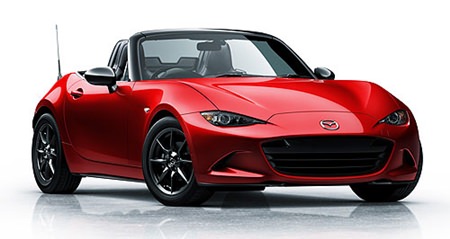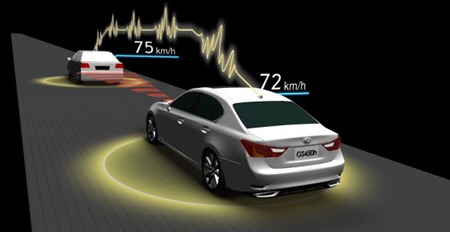New MX-5 (Miata) for 2015

New MX-5
The Mazda MX-5 (Miata in the US) has been a success story for
Mazda. Since the first model in 1989, it has become the best selling sports car
ever. Having had an early model with the pop-up headlights, I too have been a
confirmed fan of the model, despite it getting the middle-aged spread with
subsequent versions.
However, Mazda has learned the lesson and has brought the MX-5 back to be closer
to its original iteration. While the new MX-5 stays true to its front-engine,
rear-drive, two-seat, open-top format, Mazda has drawn on its SkyActiv
engineering technologies to strip more than 100 kg from the kerb weight of the
two-seat soft-top in a bid to sharpen the MX-5’s “chassis first” performance
characteristics that have drawn more than 940,000 buyers over the first three
generations.
Mazda MX-5 program manager Nobuhiro Yamamoto said the development of the new
generation became “a struggle with the model’s 25-year history. Each successive
model of the past three generations has seen slight increases in body size and
weight in response to demands,” he said.
More extensive use of aluminium and high tensile steel has assisted in the
weight loss program and adding to torsional rigidity. The original weighed 940
kg, and the new car will be around 1000 kg. The weight distribution is reputedly
once again 50:50 as the original.
And like the original, the new MX-5 returns to a lightweight folding soft-top in
place of the folding three-piece hard-top of the third generation offered in
Australia. The after-market hard top manufacturers will be rubbing their hands
over that decision!
The new SkyActiv rear-drive floor pan - which will be shared with Italian
company Fiat for a sportscar of its own - rides on double-wishbone front
suspension and multi-link rear suspension, as before.
Mazda has gone for a modern electric-assisted system to reduce both weight and
fuel consumption.
The main engine is expected to be a normally aspirated SkyActiv-G 2.0 liter
unit, producing more than the 114 kW/200 Nm of the similar engine in the new
Mazda3. However there may be a smaller capacity unit offered as well. The
current car’s 2.0 liter engine produces 118 kW.
All engines are set to be offered with a choice of six-speed manual and
automatic transmissions.
Code-named NA, the first MX-5 - distinguished by its pop-up headlights and
double-wishbone suspension - had an 86 kW 1.6 liter engine. In 1993, a 98 kW 1.8
liter engine was introduced as part of a facelift. The second generation NB MX-5
was released in 1998 with modern style fixed headlights and a more powerful 100
kW 1.8 liter engine and later lifted to 109 kW in 2001. The current NC MX-5
introduced multi-link rear suspension, 118 kW 2.0 liter engine and six-speed
gearbox in 2005.
Toyota reveals raft of safety features

AHDA in action.
As the motorcar heads towards autonomous
operation, the manufacturers also have to integrate safety systems for this next
step. Many of these systems are already in existence, but currently too
expensive for general fitment.
The latest Toyota advanced systems were revealed at the
Toyota Advanced Safety Seminar. These include:
Automated Highway Driving Assist to keep a car within its
highway lane, at a safe distance from surrounding traffic.
New, improved laser obstacle detection system.
New 3D head-up display.
Laser detection systems that can track objects on the road,
day and night; 3D information displays that transform the way traffic
information is delivered to drivers; and an advanced driving support system that
will be on the road within the next few years; these were the highlights of the
innovation program revealed at the fourth Toyota Annual Advanced Safety Seminar
in Ann Arbor, Michigan.
The seminar provided an early insight into the company’s
latest safety research and development work and the progress it is making in
securing safer mobility for all in the future.
“Toyota’s vision is of a world without traffic fatalities,
and these advanced connected and automated vehicle technologies have the
potential to revolutionize automotive safety,” said Seigo Kuzumaki, Toyota’s
Chief Safety Technology Officer. Items discussed at the seminar included:
Automated Highway Driving Assist (AHDA): First
revealed last year in Japan, Toyota’s AHDA system is designed work with the
driver to achieve safe car control. The latest version of the system, unveiled
at the seminar and to be shown at the ITS World Congress, has been programmed
according to real-world traffic conditions in the USA and can operate at speeds
up to 90 kph.
AHDA integrates three core technologies: Dynamic Radar
Cruise Control, Lane Trace Control and Predictive and Interactive Human-Machine
Interface (HMI). These support the driver by keeping the vehicle to its lane and
a safe distance from others on the road, all while travelling at cruising
speeds. The Predictive and Interactive HMI promotes driver engagement, warning
when the system is going to disengage and monitoring the driver’s level of
attention on the road ahead.
Dynamic Radar Cruise Control (DRCC): This system
allows drivers to maintain speed and make more comfortable progress while
reducing accident risk by keeping a safe distance from the vehicle ahead. It
uses a 77 GHz millimeter-wave radar to detect and monitor vehicles in front of
the Toyota and maintain specific speeds and distances.
Lane Trace Control (LTC): Lane Trace Control helps the
driver keep the car safely within its lane, using signals relayed by a
front-mounted camera and a millimeter-wave radar. The sensors detect lane
markings on the road surface and vehicle ahead. The system calculates the right
driving path, automatically adjusting the vehicle’s steering angle so the Toyota
keeps within its lane, within an appropriate margin from surrounding vehicles.
Predictive and Interactive HMI: While the improved
automation provided by the Dynamic Radar Cruise Control and Lane Trace Control
contribute to making driving safer and more comfortable, it remains essential to
keep the driver - the most important element in the driving process - focused.
For this reason, AHDA includes a predictive and interactive HMI to help there is
a smooth, safe transition as the car moves from automated and manual driving.
The system gives the driver advance warning when only limited
automated system support can be expected. It makes its predictions on the basis
of the lay-out/geometry of the road ahead and historical sensor performance.
These predictions are intelligently generated, so they apply specifically to the
traffic lane in which the AHDA vehicle is travelling.
Monitoring technologies are used to check the driver’s level
of attention on the road ahead. An infra-red camera monitors the driver’s face
and a touch sensor locates where the driver’s hands are on the steering wheel.
The system warns the driver if it detects their hands are off the wheel, or
their eyes are not on the road ahead for a long period.
Spad Lidar - single photon avalanche diode/light detection
and ranging: Toyota demonstrated its SPAD LIDAR environment mapping and
recognition system for the first time at its safety seminar, a technology that
marks important progress towards making automated driving a reality. As well as
performance improvements, the system is smaller than the previous bulky units
which had to be mounted on the roof, and can be installed inside the car.
The high-resolution LIDAR (laser radar) combines the
functions of a millimeter-wave radar and stereo cameras. It can detect the shape
and position of obstacles ahead and its active sensors mean it can operate in
daylight and at night.
3D head-up display: Toyota’s innovative 3D head-up
display reflects the company’s philosophy that advanced safety technology should
work as a teammate with the driver, and breaks new ground in interface design.
The system projects critical information onto the windscreen, such as vehicle
status, traffic conditions and road signs, rendering it in 3D with no need for
the driver to wear special glasses or use other accessories.
It uses completely new 3D viewing technology and is designed to display
information at specific points on the road.

